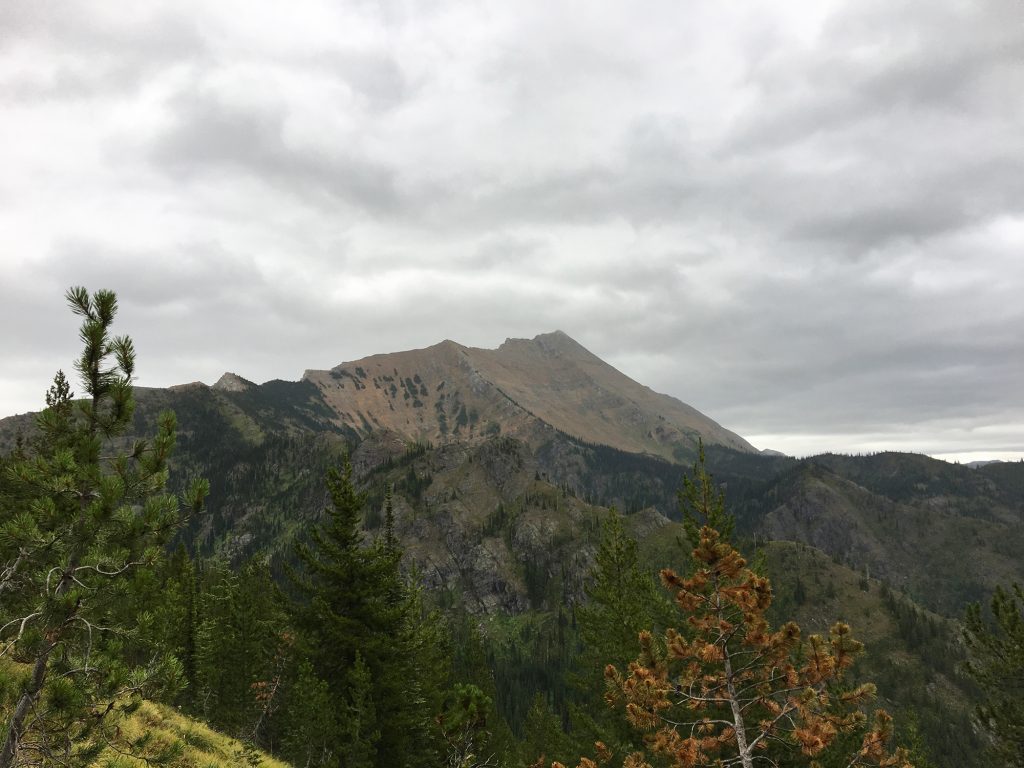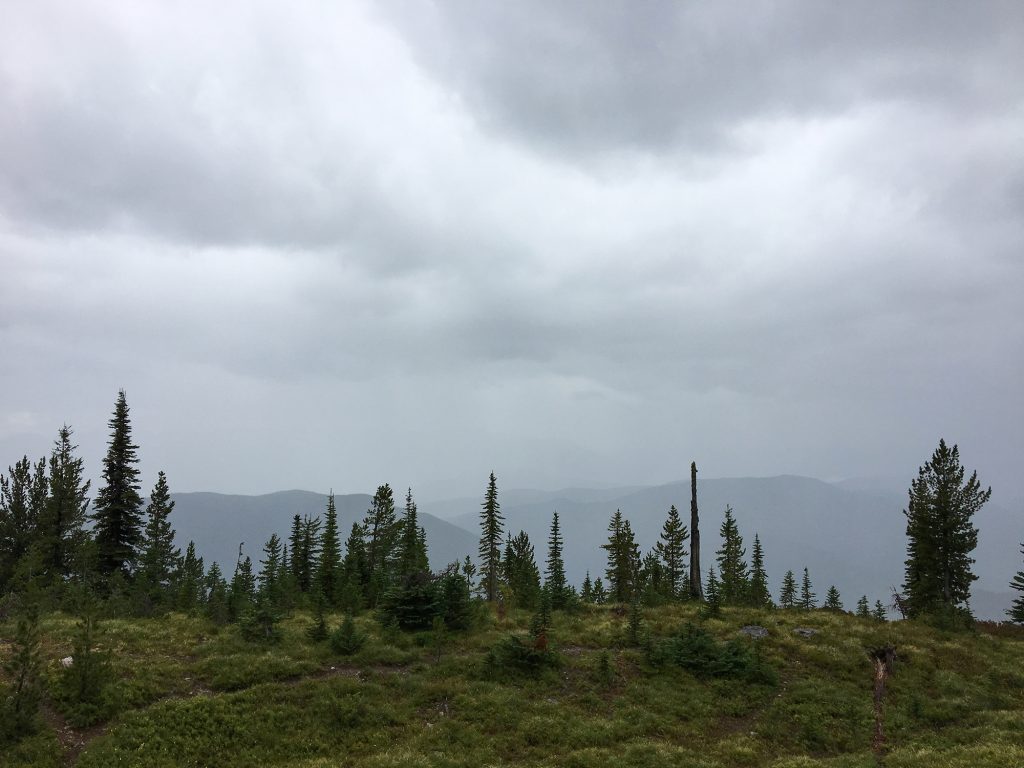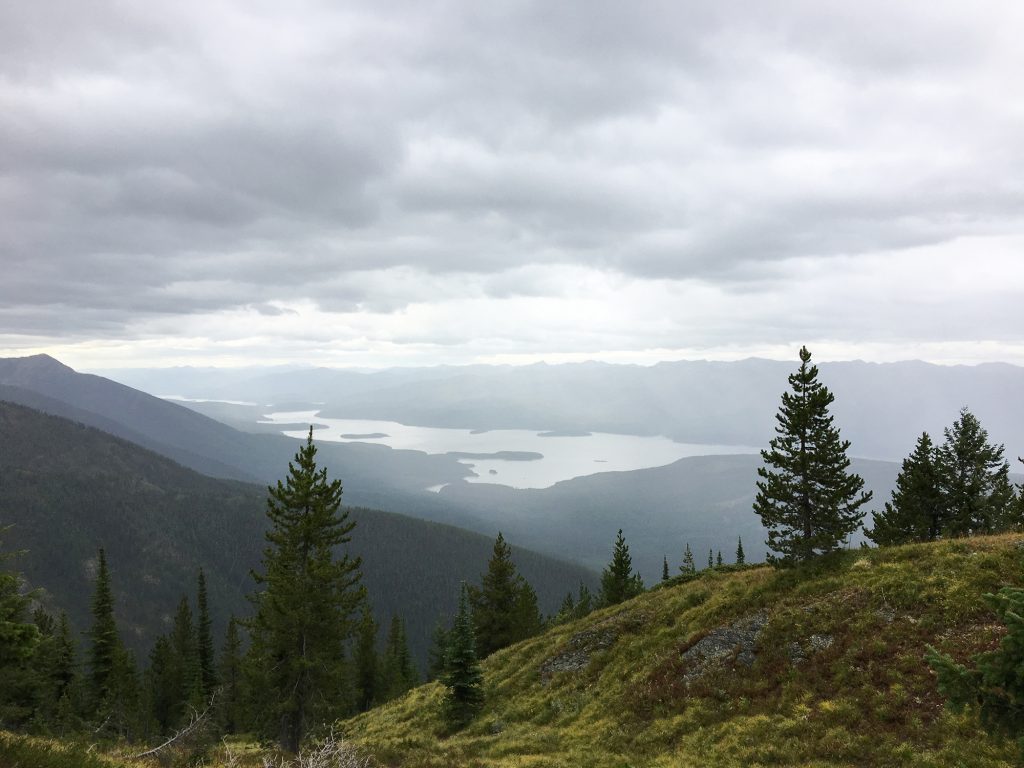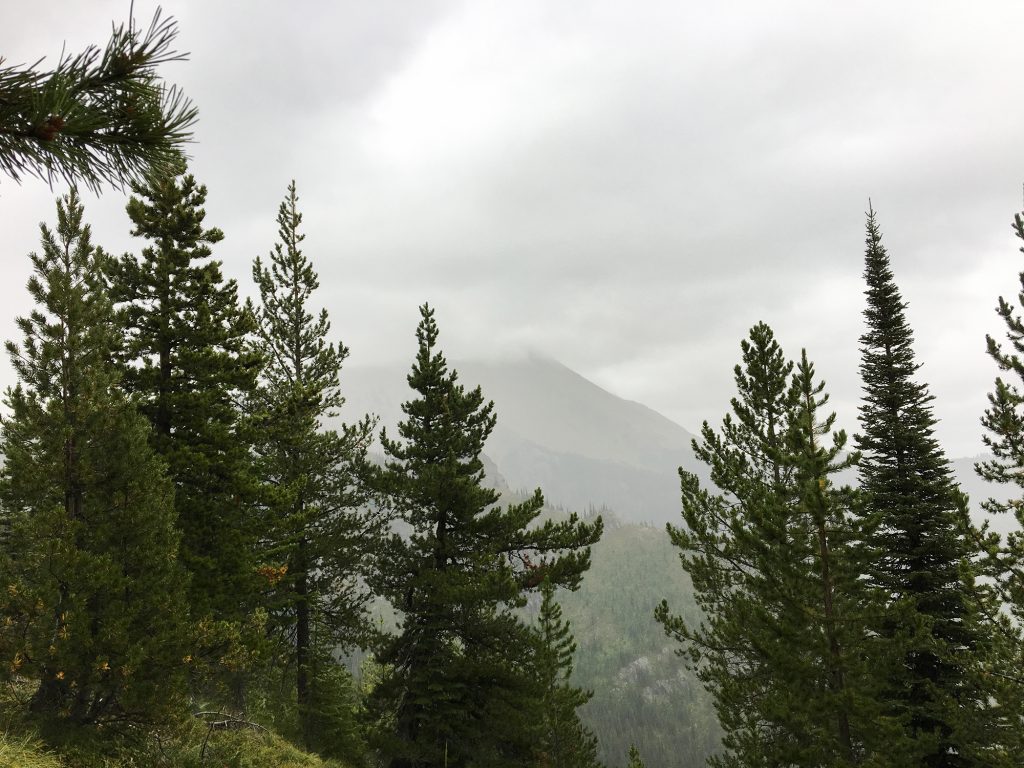Your cart is currently empty!

Knowing when to call it
—
by
If you would have told me that it was going to be raining when we reached the ridgeline, we wouldn’t have even started. Great Northern Mountain just south of Glacier National Park is a fairly popular climb that I have yet to do for some reason. Kristen and I set out on Sunday morning to give it a go.
The forecast called for thunderstorms at 1pm, so we figured we’d try and be up and down before they came. We arrived at the trailhead to a mostly overcast sky and started the brutal slog up to the ridgeline. After 2,600ft in less than two miles, we reached the ridgeline.

Looking east towards the summit, everything looked fine. There was a mild drizzle happening, but we could see the whole ridgeline (which is basically the route) and it was clear. The problem is, as you can see from the above photo, that there is a long section that’s very exposed to the weather with no cover.
To the west, however, it was a different story. The drizzle we were experiencing was just the beginning. The weather comes from the west and it was full of “adventure”.

The problem at this point is what makes good decisions hard. Like I said before, had I known the weather was going to come this early, the decision would have been easy. Don’t go. But since we had invested so much effort already, and we could see the summit, suddenly sound judgement was clouded.
As we looked south, we could see the rain move across. We got out our rain gear and went down a little bit into the trees to talk more and see if this was just a wave or the system was arriving.

To complicate matters, as we waited, a group of four, young hikers slogged their way up the ridge. We all discussed the weather that was happening and the frustrating call it was making. They decided to go up to the ridgeline and then make their call. We heard their voices for a bit, then we didn’t. They had decided to go on.
This brings in the second reason that making good decisions is hard. When you see someone making bad decisions in front of you, you begin to think that you’re soft, or maybe it’s actually okay. We looked towards the once clear summit to one that was now obscured.

We decided to walk along the ridge for a little bit “just to see”. It was windy and rainy. The summit was obscured and you could see the clouds climbing up and over the ridgeline. Essentially what was awaiting us was a sufferfest at best and dangerous at worst.
If we summited, we would be able to say that we were “tough” and did it. We would have been freezing, soaked, and in the clouds without a view. We’d have to do the whole stupid thing over again so we could actually experience the incredible views at the top.
Ultimately, we realized that, despite the effort already expended and despite the social pressure, we would be better served by simply heading down the ridge and doing the slog again when the weather was more accommodating. As we returned along the ridge, I pictured what it would be like on a beautiful fall day and realized that that was how I wanted to experience this mountain.
I’ve climbed two other mountains where I’ve summited in the clouds. I’ve since re-climbed Mt. Jackson, but still need to climb Heavens Peak again… because I didn’t really feel like I climbed it yet.
One ditch to fall in is to simply give up when it becomes hard. Inclement weather, a challenging climb, etc doesn’t necessarily mean that you have to turn around on an adventure. Some people simply bail too early.
The other ditch, however, is where people get into trouble. Make sure that when you’re making decisions, you’re being driven by the right criteria.
As we headed down, the first wave of rain had passed, but the clouds still sat on the summit. More rain followed that day with the addition of thunder and lightning. We’ll be back to climb it again…. when the sun’s out.

Comments
24 responses to “Knowing when to call it”
-

Hey Jake,
Smart move.
When totally your Glacier hiking miles does a 10 mile round count as 10 miles or 5 miles?-

All distances are total hike distances. So an out and back that is 5 miles in will be listed as 10 miles round trip.
-

Hi Jake
We recently returned from Glacier with our grandkids so no great hikes like yours.
Your post reminds me when I heard Tim Macartney-Snape, Greg Mortimer and Lincoln Hall speak about their summit of Everest October 1984.(First Australians to do so and without oxygen) Lincoln Hall did not make the summit and someone in the audience asked him why he didn’t as he was only 20 minutes from the top.
His reply has never left me. He said that he was 20 minutes from the top, he would stay there maybe 10 minutes and then descend, another 20 minutes. The weather was closing in; he did not think he had 50 minutes of time. He looked at the person who asked the question and said, “I did not think I had the time and I did not want to die.”
To have this presence of mind after aspiring to climb Everest, preparing, climbing and actually being so close to the Summit blows my mind. I left being impressed with all the climbers, but mostly with Lincoln Hall.
Sadly he passed in 2012, but that day I heard him still lives inside of me.
https://www.smh.com.au/national/a-tribute-to-lincoln-hall-20120321-1vjau.html
-

Wow! That takes some conviction!! Thanks for sharing. 😀
-
-
-

I really like this narrative. Sometimes it’s weather, sometimes it’s daylight, sometimes it’s fatigue etc… The decision making process is very dynamic and your above thought process is a good example of what to do on a regular basis!
-

And sometimes it’s pressure from other members of the group to not be a wuss. 😀
-

This reminds me of my Grinell Glacier hike (your #1 rated) with the family on vacation in July. After hiking for miles I couldn’t believe the trail was “closed” due to a snow hazard (in mid July)! It was just above the place where the trail goes through the little waterfall. If it was just me I would have risked it, but it was a different story with the kids. A broken bone or twisted ankle could have easily ruined our day or worse. We turned around, and got views of a big bull moose as a consolation prize.
-
-

Good advice, Jake, thanks!
-

You bet!
-
-

Thanks Jake for serving up this insight. The same thing happened to us near the summit of Mt. Oberlin in July. When we set out knowing we may encounter bad weather, I find it is helpful to set my mind (and the minds of others with whom I hike): “We will enjoy this hike whether or not we are able to reach the destination.”
-

“At least he died doing what he loved” meant that he no longer was able to do it. Enjoy the journey and turn around if need be. There were tons of huckleberries along the way and the views from the ridge were great! (while they lasted)
-
-

Thanks for posting this Jake. My son and I encountered a similar situation heading up to Boulder Pass from Upper Kintla this July: rainy, windy, and thunderstorms projected for the day. We ended up turning around from our Northern Traverse and heading back to Kintla.
Ended up salvaging the trip with some additional day hikes over the remaining days, but it was a grueling decision to make. Being able to recall how similar good decisions have been made by more capable and more experienced hikers is an invaluable resource.-

I think it’s even harder when you have “one chance”. Good call.
-
-

“Getting to the top is optional. Getting down is mandatory.”
-

For sure! Also, the top is only halfway. 😀
-
-

My friend and I had 25 miles left to do on the John Muir Trail this year. We figured it would be easy, hike from Tuolumne Meadows down to the valley, our victory lap on our 5th year on the trail. The problem was all the snow at higher elevations in June. Normally we go in August, but I wanted to see the Yosemite waterfalls gushing in June. Who would have thought we’d have another year like 2017? After 10 miles on the trail, there was lots of snow in the woods. I didn’t want to get lost in the woods, so we decided on an alternate trip, down to Merced Lake, and then follow the river all the way back. It turned out to be a wonderful trip with all the waterfalls going off. The trail will be there next year, and we’ll only have 15 more miles to finish it.
-

Ugh for the trip, but yay for waterfalls!!
-
-

After 36 hours of pouring rain, lightning, and thunder on the Rockwall Trail in Kootenay NP a couple of years ago, I decided I do these things to *enjoy* them, not to *endure* them. I pulled the plug and hiked back down. Maybe I can make it back out there someday. Good call on the drop back to the TH. The mountain will always be there.
-

On October 1, 1994, one year to the day after ACL surgery on my left knee at age 49, I was joined by 17 friends as we began our 22 mile / 6000 vertical foot trek up Mt. Whitney (14,495′ at that time) and back. I was pretty much a novice at high altitude hiking, but I knew it was better to be prepared than not, so I carried a 45 pound pack with enough clothing, water, food and gear to keep all of is alive for a week or two… I even carried a 6 pack of beer encased in ice! One of our group, Joel, was a genuine climber having summitted Rainier, Hood and Aconcagua among others. He was also 15 years younger and clearly a lot smarter than I. Although the skies were clear and sunny, at 11,600 feet we began encountering fresh snow from the night before. As the miles drug on, the snow became deeper, and our group split up into numerous groups. Most of the group turned around at or before Trail Crest at 13,777 feet. Joel was the first to the summit. I had passed Trail Crest and continued on to a point at about 14,000 feet where I ran into Joel on his return trip following his successful summit, with his climbing companion stuffed animal Mutzie riding on his pack. Mutzie must have looked better than I did, because Joel immediately began to try to convince me to turn around without reaching the top. That seemed pretty silly after coming this far, since I was only a mile away, and the steepest part was behind me. Nonetheless, Joel, who had climbed a mountain over 8000 feet higher than Mt. Whitney kept stressing “the mountain will always be here, and you don’t want to be climbing down the icy switchbacks in the dark.” “Yeah, I’m sure that’s probably true.” I thought, “But I might not ever be here again.” Nonetheless, I did have those icy switchbacks to deal with on the descent, and I did not relish negotiating them alone. At the pace I was going, the summit was at least an hour away. That, and the fact that we only had five hours of daylight left, was enough to convince me to turn around. Joel was nice enough to offer to slow his return trip to match my snail’s pace, and accompany me back down through the ice and snow.
On the steepest switchbacks on the descent, my 6′ 4″ frame was so top heavy from the pack I was carrying, that it was all I could do just to keep from tipping over. On several turns, Joel literally held me on the mountain by grabbing the top of my pack from above and halting my slides downward.
About a mile from the trail-head, my right hamstring started cramping. It was so bad that I couldn’t straighten it out for about 10 minutes. I was finally able to stand, but I couldn’t bend over to pick up my pack without it re-cramping. Joel saved me again. He carried both of our packs for a ¼ mile or so until I was able to work out the cramp and re-mount the now 35 pound “sporting goods store” and beer on my back.
It was dark by the time we reached the trail-head, so the remains of our group that had hung around, sat on a log and we all drank the beer I had carried up and down without ever taking a sip…
To this day, I still thank Joel for convincing me to turn around. A year later, in better shape, and in June with longer days, I made it to the summit of Whitney and back down in three hours less, with no problems. Joel was right – the mountain was still there, and I lived to tell about it!
-

For anyone who wants to greatly improve your chance of avoiding our human propensity to do stupid things such as ignoring evidence we should turn around, read: “Deep Survival” by Laurence Gonzales (his “Everyday Survival” & “Surviving Survival” are great follow-ups, too!), not to mention “Death in Glacier National Park” by Randi Minetor and “Death and Survival in Glacier National Park” by C.W. Guthrie & Dan & Ann Fagre.
-

Excellent call. There are too many stories of people not turning around.
-

Sage wisdom here, Jake. Always worth reinforcing. Thanks for taking time to share it.
‘The mountain will always be there’: So true. Or in my case, the Teton Crest Trail will always be there.
I set out from Jenny Lake in early September 2010 on a four-day expedition southward along the TCT, with Wyoming’s Highway 22 as my planned finish line. But the light snow projected for the first evening became an all-night-and-into-the-following-morning snowstorm. So after a discomforting 14 hours in my three-season tent, I headed back to Jenny Lake via Cascade Canyon rather than stumble my way over something called Hurricane Pass in ghastly weather. I was unharmed, but a bit bummed about the turn of events. I’m from California, so the Tetons aren’t exactly in my backyard.
I returned to Jackson Hole with my amigo Drew (an Appalachian Trail completist) in August 2014 with a different four-day route in mind: Jackson Hole Mountain Resort Aerial Tram —> Teton Crest Trail via Death Canyon Shelf, Alaska Basin, Hurricane Pass, and Paintbrush Divide —> String Lake Trailhead. We had mostly cooperative weather before running into an insane, but manageable — and frankly, exhilarating — hailstorm going over Hurricane Pass on our third day. Sitting at our campsite early that evening in Cascade Canyon’s North Fork, we reckoned we were in the clear. Wrong. It wasn’t even dark yet when one of those punishing Rocky Mountain summer rainstorms blew in, and it didn’t let up all night. That one broke our resolve, and rather than fight our way over dodgy Paintbrush Divide amid inclement conditions, we cut back to Jenny Lake via Cascade Canyon and went face-deep into burgers and huckleberry pie up the road at Jackson Lake Lodge. We were unharmed, but this time I wasn’t so bummed — I knew I’d be back within a few years to finally put the wraps on this elusive goal.
Five years later to the week, in August 2019, I knocked out the Paintbrush Divide loop on a straightforward, completely enjoyable overnighter with zero weather drama (and a Hike 734 map in my pocket!). I foiled a bear’s plans to invade my campsite, I watched an epic moonrise, I reclined next to Lake Solitude, I absorbed every vista along the way. It was a first-rate adventure for the ages.
And for the third time in the ‘10s, I hiked down to Jenny Lake via Cascade Canyon…and for the first time, it was part of my planned itinerary.
-

Hey Jake, I was shocked when I read this because just this summer season I had basically identical experiences with the same mountains, and I did Great Northern about a week after you did :). For me, Great Northern was clear all the way up and then foggy from the ridge line to the summit, but not rainy or hazardous. Although, I was so frustrated because I had just summited Heaven’s Peak, that’s been number one on my list to summit ever since I first came to Glacier, and the summit was completely fogged over too, so I also didn’t feel like I had truly summited. This season brought a lot of fog and also a lot of growing pains as a hiker, learning when to call it and when to keep on.
-

Hey, Jake! We met you in Yosemite although I had read your blog before we went. We are thinking of hiking the Rockies. I have kept putting it off because of having to be off the summit by noon and that means getting an awfully early start. It was good to read about your having to decide whether to go on after you had come so far, especially when others went on ahead.
My husband is interested in bagging peaks and was disappointed in our recent hike to the White Mountains that we were there on days when thunderstorms were predicted and were unable to complete a hike he could brag about. We were hiking the Ammonoosuc Ravine Trail and I said we need to turn around even though we wanted to go higher. Just after we returned to the parking lot, a torrential rain began and even with our rain gear, it would have been dangerous and miserable if we had still been hiking. It’s a long drive from Ohio so I don’t know if we’ll ever be able to go back.
However, we’re still alive. I lost a sister to a bad decision–not hiking but boogie boarding in Hawaii and not taking the warnings seriously. She became paralyzed from the neck down and then died a couple years later.
Sometimes I worry I’m being too cautious but I’m 73 and I still want to be able to hike for as many years as I can. So, it did help to hear your tale of caution.


Leave a Reply